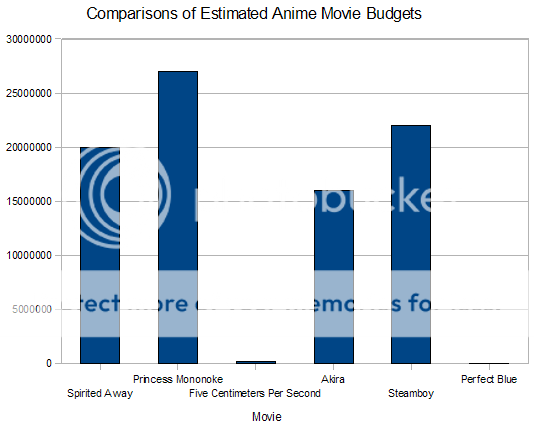Quote:
Originally Posted by TinyRedLeaf

How much lower are we talking about, actually? Happily, it turns out that a Makoto Shinkai fan has done some of the homework for us. Given the frequent comparisons between Shinkai and anime-god Hayao Miyazaki, he decided to compare the budgets of some of their movies.
 Credit: Nick's Anime Weblog (Oct 13, 2008)
Credit: Nick's Anime Weblog (Oct 13, 2008)
The Y-axis represents US dollars, adjusted for inflation. Caveat: He got his figures from IMDb, so they are by no means authoritative. Nonetheless, an important point is still served: New computer technologies are both enablers and destroyers of future anime content.
Makoto Shinkai and his small team of amateur collaborators independently produced a roughly 60-minute animated movie, of comparable quality to a Ghibli film, on the most raggedy shoestring budget you could possibly imagine: around US$220,000 in 2007.
With costs that low, you don't really need that much to break even, now do you? 
So, yes, the times are a-changin'. Amateur or professional, if you're talented enough to produce top-quality content that someone is willing to pay for, you're in business. Then and now, necessity will always be the mother of all invention. |
I definitely think so too. Overall a leaner industry is a good thing, both on the production/technical and business side. It reminds me of the fan-made Star Wars
Revelations film which had a budget of $15k to $20k according to wikipedia. Now this makes me wonder about the costs of other smaller or more independent producers, like from doujinshi circles. Touhou projects? Eve no Jikan?
I also wonder about those who have broken out of their doujin origins, like Type-Moon and authors of Higurashi and how compare with other TV shows, like Samurai 7 for example which I heard had huge costs. In a documentary, it seems like the two persons working on the original Higurashi game worked with a bugdet of like.. ¥0

Going back to production methods, I'm still surprised at how much manual labor goes into the animation. Even if you don't use traditional cells and everything is digitized and painted digitally, the animation itself for many shows is still completely done by hand. I guess even Korea's becoming too expensive for the in-between frames so that work is going to Philippines and China. But I don't think it has to be that way. Even key-frame work can be more streamlined. A lot of US cartoons (e.g. Saturday morning toons) are completely vectorized. You can use skeletal based animation, even cell-shaded animation without having to stick with the physics of the modeling (i.e. do free-form adjustment of the final 2D-projected object and interpolate the frames from those points).
I'm not sure if there is software to do this yet, but I think that VA work can also be improved with some method to automatically sync and animate lip flaps. There are a few methods to do this. You can do beat analysis on the audio to extract the timing for the syllables and combine that with the script to perform the automation. Or you can do full blown voice recognition (probably not accurate); or either attach motion sensors to the VA's mouth or do video analysis on their lip movement. This would also greatly assist with dubbing in other languages as well, if you had a process to re-render the entire show, keeping everything the same but changing the lip flaps. I think this would improve dubbing VA performance too, in my humble opinion.
Anyways, none of this will matter if much of the cost -- and compensation -- is on the business side.